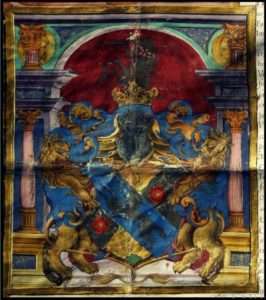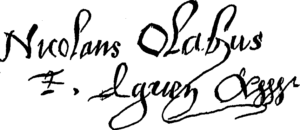Who was Oláh Miklós? (1493-1568)

Oláh Miklós (Nicolaus Olahus) was born in Nagyszeben /Sibiu/ on January 10, 1493 and died in Pozsony /Bratislava/ on January 15, 1568. He was one of the most influential people in Hungary in the 16th century. His mother was Hungarian, while his father was Romanian (Walachian). His mother, Huszár Borbála, came from a civic family in Szeben and was related to the Bogáths and the Gerends, who were also related to the Hunyadi family. We can say that he considered himself a ” Hungarus “, similar to other Latinists of the time in the Kingdom of Hungary. The “Hungarus-consciousness” is a territorially based cultural identity, which connected people living in Hungary until the late 18th century.

Oláh Miklós was the son of Oláh István. Oláh István was the son of Hunyadi Mária, who was the sister of Hunyadi János, the governor of Hungary. At the same time, his father was related to the Voivode of Wallachia and was the royal magistrate of Szászváros, one of the leading officials of the Transylvanian salt mines, the Salt Chamber, and his brother Máté was also the royal magistrate of Szászváros (Orăștie, Broos).

His name, Oláh, is an indication of his ethnic origin (the word Oláh is derived from the word “vláh”, which means “Romanian” (Wallachian)). Between 1505 and 1512 he was educated in the chapter school of Nagyvárad (Oradea). Oláh continued his education at the Jagiellonian court in Buda, at the court of King Ulászló II (Vladislav II Jagellonský).

After the Battle of Mohács in 1526, he fled to the Netherlands (1532-1539), where he studied and made contact with leading Latinist intellectuals such as Erasmus of Rotterdam. (Their correspondence is an important historical source on the history of the Dutch Latinists). During this time, from about 1535 to 1537, he was private secretary to Queen Maria Habsburg of Hungary, who later became regent of the Netherlands.

It was the time when he wrote a detailed description of Hungary (1536), the first of its kind. He was good at recognizing talented young writers whose studies he supported. He supported, among others, Forgách Ferenc, Istvánffy Miklós and Zsámboki János. Oláh also played an important role as a politician. The first letter of ennoblement of Oláh Miklós, dated November 23, 1548, was issued in Pozsony (Bratislava) by Ferdinand I, King of Bohemia and Hungary (later Emperor of the Holy Roman Empire of the German Nation, from 1556).
The diploma was written by Várdai Pál, Bishop of Esztergom, and signed by the Emperor, who praised the Transylvanian humanist for his “excellent knowledge of all the fine arts, for his understanding of the Greek and Latin languages, for his talent in writing, for his poetic talent”.

Oláh was the head of the Chancellor’s Office between 1543 and 1568 and was appointed Governor of Hungary between 1562 and 1568. Between 1549 and 1553 he was the Archbishop of Eger, and he financially supported the fortification of the Eger Castle, so that he could contribute to the successful defense of Dobó István’s castle in 1552, although he was not personally present during the siege. After 1560 he was also the Chief Comes of Hont county.

His work was important because he helped to organize the smooth coordination between the Hungarian Estates and the monarch. This coordination enabled the Hungarian Estates to make good use of their resources and to make the best military effort to prevent the Ottoman Empire from conquering Hungary.
Oláh was archbishop of Esztergom between 1553 and 1568 and was able to bring about changes and reforms by visiting churches, organizing synods, reforming monasteries, and settling Jesuits in Hungary, not to mention establishing clerical seminaries that are still active in the 21st century. Among the publications initiated by Oláh were the Breviarium Ecclesiæ Strigoniensis (1558) and the Ordo et Ritus Ecclesiæ Strigoniensis (1560). He also revived the custom of ringing the Angelus.

Why can he be important to us today?
Oláh Miklós was both a Transylvanian and a European, but first and foremost he was a Hungarian, a ” Hungarus” of Romanian origin. He had witnessed Mohács and the catastrophe of the partition of Hungary. After fleeing abroad, he wrote his most important works and became a member of the European Latinist elite.
But although he lived in Brussels, he never forgot his roots, and it was there that he wrote his most important books, Attila and Hungaria. He soon returned home to serve his country not only with his writings but in other ways as well. His works contain rich descriptions of Hungarian history – mainly based on Thuróczy’s Chronicle – geography and economy, especially of Transylvania. His works were already translated into several languages in the 16th century.

Even in the darkest times, Oláh Miklós believed in the survival and rebuilding of Hungary, trusting in the power of knowledge. And he worked hard to achieve this goal. He is an excellent example of how to survive the chaos with an unbroken backbone, and how to work amid confusion when all the values that were thought to be eternal seem to be gradually fading away.

Source: ELTE BTK Kora Újkkori Történeti Tanszék, and Hungarian Wikipedia
Dear Readers, I can only make this content available through small donations or by selling my books or T-shirts.
If you like my writings, please feel free to support me with a coffee here:
You can check out my books on Amazon or Draft2Digital, they are available in hardcover, paperback, or ebook:
https://www.amazon.com/dp/198020490X
or at https://books2read.com/b/boYd81


My work can also be followed and supported on Patreon: Become a Patron!http://Become a Patron!


https://hungarianottomanwars.myspreadshop.com/all
[wpedon id=”9140″ align=”left”]


